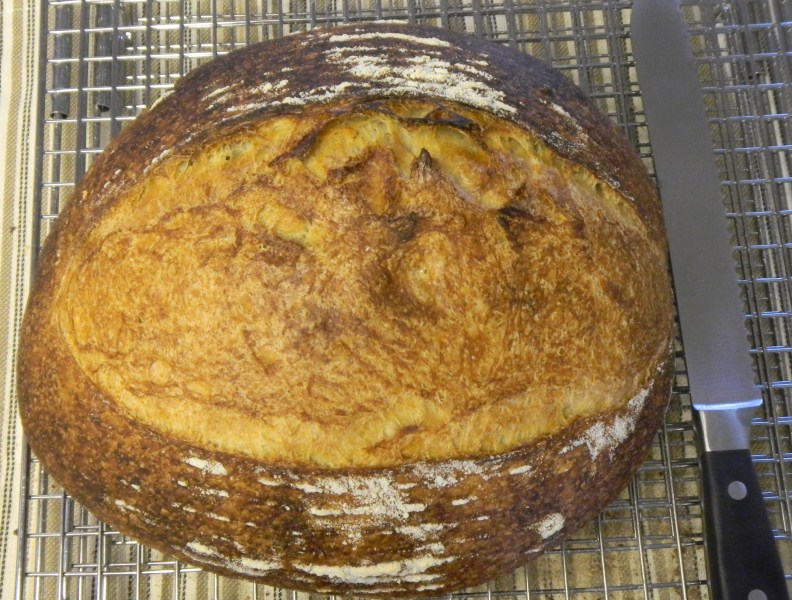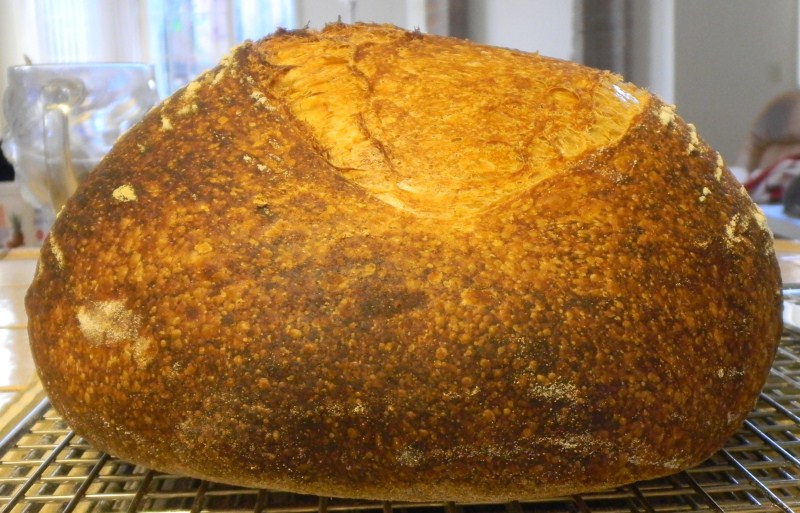Hello,
Here was today's bake. I had some good results recently with this recipe at 775-gram loaves, so I tried it at 1362-grams, about 3lb. I wanted to see if the extra weight would make a more closed crumb. This was 90% white bread flour, 10% whole-wheat flour. Overall dough hydration was 68%. 25% was a leaven at 125% hydration, 46% was flour-soaker at 80% hydration. Mixed the remaining flour, salt, bulk fermented for 3 hours, and a short final ferment of 45 mins, then baked on the stone w/steam for first 15 mins. Tastes great!
Here's the pictures. It was a little misshapen, I was not used to handling a larger dough.





I concluded the crumb was a little more closed than a lighter weight bread, but I am happy with it.
Cheers, and happy baking!
Gorgeous looking bread! Love the blistering. :)
Syd
Wow. What a crumb! It doesn't look misshapen to me in the slightest. Could you talk a little more about the flour soaker? What does it do for the quality of the bread?
beautiful loaf! crumb, crust to perfection. can you tell us more about the formula and the method you used? did you used yeast? only 45 min for the final proof? Share the details, please.
codruta
Hello,
Thanks! But I think the crumb was too closed for a mostly plain white bread. I have done better. Here is another recent one I did, basically the same but with a little rye also. http://www.thefreshloaf.com/node/24249/another-iteration-regular-bread
I think this one was just too heavy.
IBringThePain -- I think the flour soaker, even using white flour, improves flavor. I believe it is related to inducing amylase enzyme activity on the starches which converts to sugar molecules. I can tell a distinct difference between my breads done with or without a flour soaker.
Codruta, the final 45-min ferment was me watching the dough, not the clock. I learned a neat trick from this site, of taking a small chunk of final dough and putting into a small clear measuring cup -- what I look for is both the rise but more importantly, the level/amount of CO2 bubbles.
I did not add any bakers yeast. Temperature control wasn't too much of a factor but this was the overall weights/measures (rounded), in grams:
One thing to keep in mind, depending on circumstances, you want to be careful with flour soakers.
I read online about amylase experiments in a scientific environment, and the ideal temp for conversions of starch to sugars was 80F.
So I tried it, for 24 hours at 80F. I made a nice spoiled soaker, and I even put a 1% level of salt in it, if I recall correctly. It was rancid. :-)
Since then, I've been doing my flour soakers with 2% salt and keeping them at 60F, which is what I also keep my liquid white-flour starter at, but I don't put salt in my starter, and it's fine. I'm just paranoid about the soaker because of the one time failure in the past, so I add salt to it, and don't put it higher than 60F. That's just me though. :-)
-gvz
I'd be very, very happy if I find the crumb like this when I sliced my bread! And the crust is beautiful, too. :)
Have you made a smaller loaf with the same recipe? If you have, I wonder if there's any difference in flavours.....
Thank you. I have, links provided before. Flavor was about the same.
OK, thanks. :)
You make nice looking loaves. How do you generate steam in your oven? Thanks.
I bought a hand-held steamer. McCulloch is the maker. It has a small nozzle, which I insert into a hole punched into a metal hood that I place on top of the bread (on the stone).